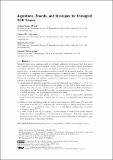Algorithms, bounds, and strategies for entangled XOR games
Author(s)
Watts, Adam Bene; Harrow, Aram W.; Kanwar, Gurtej S.
DownloadPublished version (537.9Kb)
Publisher with Creative Commons License
Publisher with Creative Commons License
Creative Commons Attribution
Terms of use
Metadata
Show full item recordAbstract
Entangled games are a quantum analog of constraint satisfaction problems and have had important applications to quantum complexity theory, quantum cryptography, and the foundations of quantum mechanics. Given a game, the basic computational problem is to compute its entangled value: the supremum success probability attainable by a quantum strategy. We study the complexity of computing the (commuting-operator) entangled value ω∗ of entangled XOR games with any number of players. Based on a duality theory for systems of operator equations, we introduce necessary and sufficient criteria for an XOR game to have ω∗ = 1, and use these criteria to derive the following results: 1. An algorithm for symmetric games that decides in polynomial time whether ω∗ = 1 or ω∗ < 1, a task that was not previously known to be decidable, together with a simple tensor-product strategy that achieves value 1 in the former case. The only previous candidate algorithm for this problem was the Navascués-Pironio-Acín (also known as noncommutative Sum of Squares or ncSoS) hierarchy, but no convergence bounds were known. 2. A family of games with three players and with ω∗ < 1, where it takes doubly exponential time for the ncSoS algorithm to witness this. By contrast, our algorithm runs in polynomial time. 3. Existence of an unsatisfiable phase for random (non-symmetric) XOR games. We show that there exists a constant Ckunsat depending only on the number k of players, such that a random k-XOR game over an alphabet of size n has ω∗ < 1 with high probability when the number of clauses is above Ckunsat n. 4. A lower bound of Ω(n log(n)/ log log(n)) on the number of levels in the ncSoS hierarchy required to detect unsatisfiability for most random 3-XOR games. This is in contrast with the classical case where the (3n)th level of the sum-of-squares hierarchy is equivalent to brute-force enumeration of all possible solutions.
Date issued
2019-01Department
Massachusetts Institute of Technology. Department of PhysicsJournal
Leibniz International Proceedings in Informatics, LIPIcs
Publisher
Schloss Dagstuhl, Leibniz Center for Informatics
Citation
Watts, Adam Bene et al. “Algorithms, bounds, and strategies for entangled XOR games.” Leibniz International Proceedings in Informatics, LIPIcs, 124, 10, 10th Innovations in Theoretical Computer Science Conference, ITCS 2019, January 10-12, 2019, San Diego, CA: 1-18 © 2019 The Author(s)
Version: Final published version
ISBN
9783959770958